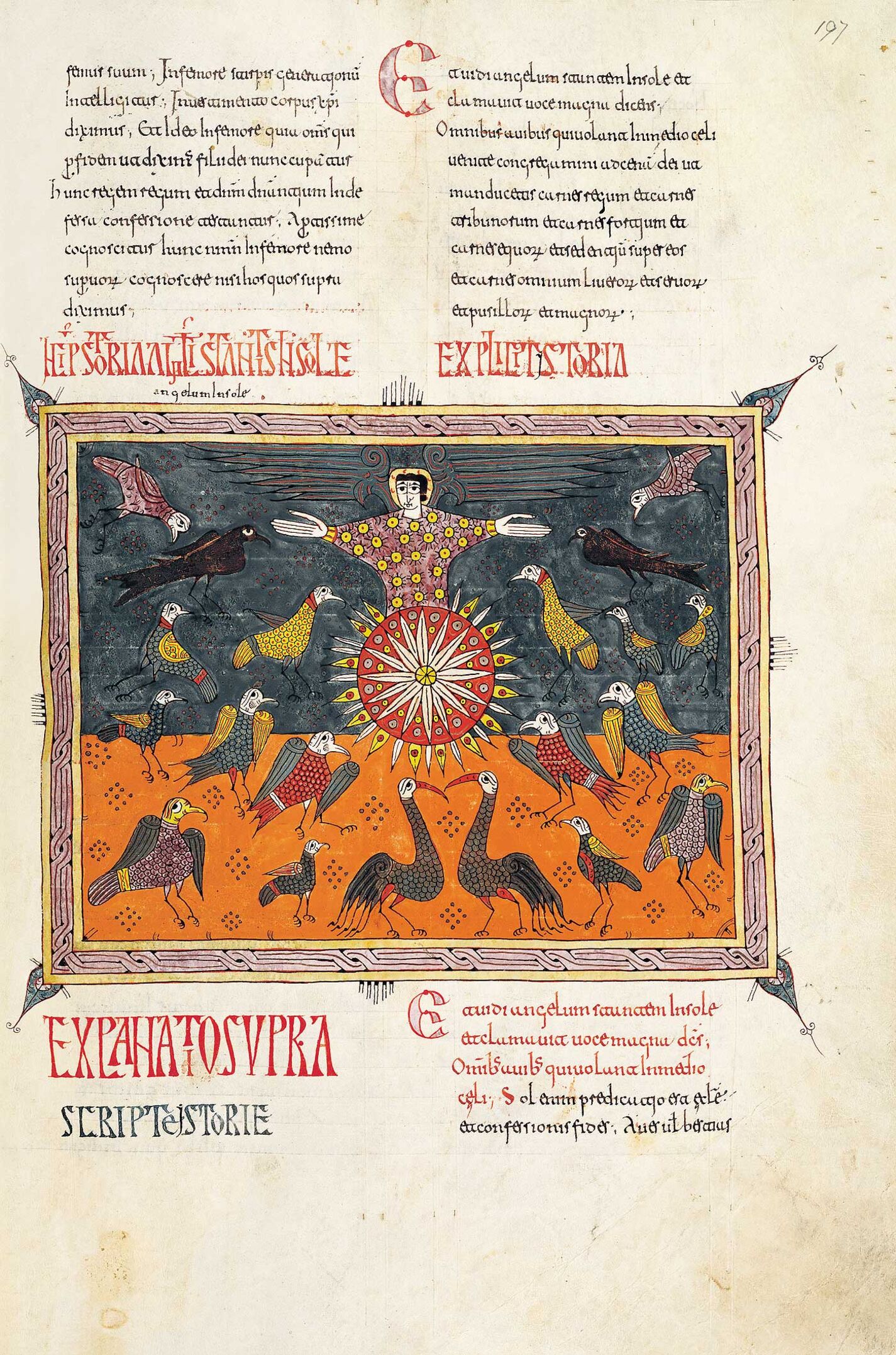Although the layout is not very different in stemmata I and II, the latter – created by
Maius – was more popular and served as the basis for the illustration in Girona (f. 222r), Valcavado (f. 172v) Ferdinand I (f. 241r) and that of Silos too. It covers the two columns and employs a symmetrical structure with the angel – the same one that fought the dragon – upon the sun in the centre. The sun in the explanatio represents the preaching of the church and the faith in the Catholic church. Many birds flock around him, also in a clearly symmetrical layout. The birds represent those who listen to the word of God and who are, in line with the storia, to eat the flesh of the enemies of the Church. The words omnes aves found in Osma, are absent from stemma II codices. Since there was no room for the legend about the angel in the Silos Beatus (angelum in sole), probably because of layout considerations, it was shifted to outside the frame and positioned above it at the top. Particular attention has been paid to the birds which are drawn in meticulous detail. Identifying them as real birds would however be rather problematic since some of them feature characteristics of different species. The two in the centre at the bottom have the body and legs of a wading bird, perhaps a flamingo, the beak of a stork and the tail of a peacock. In general they mimic typical bird shapes, which suggests that the miniaturist was not very familiar with ornithology. Indeed, it is difficult to venture that they were inspired by any treatise on birds and the miniaturist may possibly have interpreted the birds he knew de visu in his own way. The small bird in the top right-hand corner is reminiscent of a dove and the bird complementing it vaguely recalls a partridge. There are also two black ravens and the others are birds with feathers of different colours arranged in a tapestry effect. The eagle mentioned in Book 5 (Rev. 8: 12-13) crying ve, ve, ve and blocking out one third of the sun is not depicted.
The initial E[t uidi angelum...] at the beginning of the text consists of simple stokes in the form of arches ending in triangles.
E[t uidi angelum stantem...]. This E is another of the arched type of letters with horizontal strokes formed by triangles. It is outlined in red against a violet ground.
Ángela Franco Mata
(Head of the Department of Mediaeval Antiquities of the Museo Arqueológico Nacional)

Although the layout is not very different in stemmata I and II, the latter – created by
Maius – was more popular and served as the basis for the illustration in Girona (f. 222r), Valcavado (f. 172v) Ferdinand I (f. 241r) and that of Silos too. It covers the two columns and employs a symmetrical structure with the angel – the same one that fought the dragon – upon the sun in the centre. The sun in the explanatio represents the preaching of the church and the faith in the Catholic church. Many birds flock around him, also in a clearly symmetrical layout. The birds represent those who listen to the word of God and who are, in line with the storia, to eat the flesh of the enemies of the Church. The words omnes aves found in Osma, are absent from stemma II codices. Since there was no room for the legend about the angel in the Silos Beatus (angelum in sole), probably because of layout considerations, it was shifted to outside the frame and positioned above it at the top. Particular attention has been paid to the birds which are drawn in meticulous detail. Identifying them as real birds would however be rather problematic since some of them feature characteristics of different species. The two in the centre at the bottom have the body and legs of a wading bird, perhaps a flamingo, the beak of a stork and the tail of a peacock. In general they mimic typical bird shapes, which suggests that the miniaturist was not very familiar with ornithology. Indeed, it is difficult to venture that they were inspired by any treatise on birds and the miniaturist may possibly have interpreted the birds he knew de visu in his own way. The small bird in the top right-hand corner is reminiscent of a dove and the bird complementing it vaguely recalls a partridge. There are also two black ravens and the others are birds with feathers of different colours arranged in a tapestry effect. The eagle mentioned in Book 5 (Rev. 8: 12-13) crying ve, ve, ve and blocking out one third of the sun is not depicted.
The initial E[t uidi angelum...] at the beginning of the text consists of simple stokes in the form of arches ending in triangles.
E[t uidi angelum stantem...]. This E is another of the arched type of letters with horizontal strokes formed by triangles. It is outlined in red against a violet ground.
Ángela Franco Mata
(Head of the Department of Mediaeval Antiquities of the Museo Arqueológico Nacional)